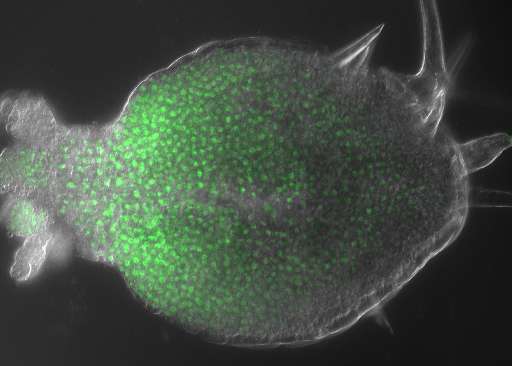Building a morphogen gradient by simple diffusion in a growing plant leaf

In an article published on September 5 in Biophysical Journal, Associate Professor Kensuke Kawade at the Okazaki Institute for Integrative Bioscience and National Institute for Basic Biology in Japan showed that a transcriptional co-activator ANGUSTIFOLIA3 (AN3) forms a signaling gradient along the leaf proximal-to-distal axis to determine the cell-proliferation domain. In particular, by experimental and theoretical approaches, they demonstrated that pure diffusion in a growing tissue is sufficient to explain the AN3 gradient formation. This work provides evidence that the diffusion-based model of morphogen is viable in developmental patterning of multicellular organisms.
Spatial gradient of signaling molecules is critical for establishing developmental patterns of multicellular organisms. Around a half-century ago, researchers proposed a theory that pure diffusion of signaling molecules from a restricted source may explain the establishment of such tissue-scale gradients (Crick, 1970). Despite the prominence of this diffusion-based model in development, quantitative studies, largely performed in animals, have not yet demonstrated this simple mechanism in multicellular tissues.
In an article published in the Biophysical Journal, Dr. Kawade's team at OIBB/NIBB, in collaboration with scientists in the Institut Jacques Monod (France), Rikkyo University (Japan) and University of Tokyo (Japan), solved a longstanding argument of the diffusion-based model for morphogen gradient formation. They measured molecular transport through plasmodesmata, a unique cellular channel in plants directly connecting neighboring cells, using trans-scale FRAP (Fluorescence Recovery After Photobleaching) assays. This analysis revealed biophysical properties of diffusive molecular transport through plasmodesmata. Based on this diffusion-based framework, they demonstrated that the AN3 gradient could be achieved solely by pure diffusion process through plasmodesmata in developing leaf primordia. Because the AN3 signaling gradient corresponds to the cell-proliferation domain, this study can explain how spatial and temporal dynamics of cell proliferation, and therefore tissue growth, is regulated during leaf development.
These discoveries provide a significant step forward in the understanding of how diffusion governs developmental patterning in multicellular organisms.
More information: Kensuke Kawade, Hirokazu Tanimoto, Gorou Horiguchi and Hirokazu Tsukaya. Spatially different tissue-scale diffusivity shapes ANGUSTIFOLIA3 signaling gradient in growing leaves. Biophysical Journal. Published online 5th September, 2017. DOI: 10.1016/j.bpj.2017.06.072
Journal information: Biophysical Journal
Provided by National Institutes of Natural Sciences




















